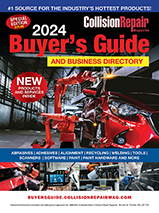FRAMINGHAM, Mass.–(BUSINESS WIRE)–#AV–The migration toward fully autonomous vehicles is being enabled by the gradual introduction of multiple, interrelated safety technologies. Feature by feature, these technologies add new capabilities that assist the safe and efficient operation of new vehicles and move the market toward an increasingly autonomous future. According to a new forecast from International Data Corporation (IDC), the number of vehicles capable of at least Level 1 autonomy will increase from 31.4 million units in 2019 to 54.2 million units in 2024, representing a five-year compound annual growth rate (CAGR) of 11.5%.
All light-duty vehicles shipped and retrofitted during the 2020–2024 forecast period will have a specific level of vehicle autonomy. To determine the autonomy level for each of these vehicles, IDC utilizes the industry definition established by the Society of Automotive Engineers’ (SAE) J3016 “Levels of Driving Automation” standard. These definitions can be summarized as:
- SAE Level 0 — no automation: All dynamic driving tasks are performed by the human driver.
- SAE Level 1 — driver assistance: Autonomous driving functions may situationally assist by providing either active steering or braking/acceleration for certain dynamic driving tasks. The driver remains responsible and in control of the vehicle and all other dynamic functions.
- SAE Level 2 — partial driving automation: Autonomous driving functions may situationally assist by providing both active steering and braking/acceleration support for specific dynamic driving tasks. The driver is expected to remain attentive, be in control, and is responsible for all other dynamic functions.
- SAE Level 3 — conditional automation: The autonomous driving system (ADS) will perform all dynamic driving tasks on behalf of the driver under certain environmental and roadway situations. The driver must always remain prepared to intervene and take active control of the vehicle, should the ADS deem such a request necessary.
- SAE Level 4 — high automation: When enabled, the ADS can perform all dynamic driving tasks under certain environmental and roadway situations (often referred to as the system’s operational design domain [ODD]). There is no requirement for a driver to be present or attentive.
- SAE Level 5 — full driving automation: When enabled, the ADS can autonomously perform all dynamic driving tasks across all combinations of roadway and environmental conditions. There is no requirement for a driver to be present or attentive.
While fully manual, driver operated vehicles (SAE Level 0) currently represent the majority of units manufactured worldwide, it remains the only autonomy level that will decline over the forecast period. This decline is a result of the automotive industry’s commitment to advanced driver-assistance systems (ADAS), as well as advancements across the areas of technology, cost efficiency and scale, consumer choice, and government regulation. As a result, vehicles with some degree of automation (SAE Levels 1-5) will represent more than 50% of all vehicles produced by 2024.
Vehicles capable of SAE Levels 1 and 2 autonomy represent the two largest area of autonomous growth and will receive the largest share in both investment and advancement during the forecast period. Because drivers must remain vigilant and in full operational control when these technologies are enabled, their introduction represents a more acceptable level of risk and liability for both vehicle manufacturers and government regulators.
Manufacturer sentiment toward SAE Level 3 technology has recently improved, including support for limited domains, such as high-speed and low-speed highway driving. IDC expects these systems will be deployed in increasing numbers in the outer years of the forecast.
Fully autonomous SAE Levels 4 and 5–capable vehicles will remain the aspirational, revolutionary goal that has fueled the billions of dollars in investment by new and traditional automotive ecosystem companies. The development and deployment of these vehicles will require significant advances in technology, customer readiness and trust, and government regulation. Consequently, IDC does not expect any SAE Level 5 vehicles to be available worldwide during the forecast period.
Overall, when reviewing the impact of the consolidated category of highly automated vehicles (SAE Levels 3-5) on global shipments, IDC forecasts that the industry will begin its growth curve upwards from a modest 2019 unit basis to achieve more than 850,000 units by 2024.
“The pathway to increased vehicle autonomy will be largely built on gradual feature and capability advancements,” said Matt Arcaro, research manager, Next-Generation Automotive and Transportation Strategies at IDC. “Although SAE Level 4, full self-driving vehicles will capture media headlines and will deliver tremendous value to society, the impact of SAE Levels 1 and 2 vehicle growth over the forecast period remains too large to be ignored.”
The IDC report, Worldwide Autonomous Vehicle Forecast, 2020-2024 (IDC #US46767820), examines the worldwide and U.S. autonomous vehicle market for the 2019–2024 period. A five-year growth forecast for this market is shown for 2020–2024. The forecast incorporates the impact of COVID-19 on all forecast assumptions for all markets, according to the most recent macroeconomic inputs from the last week of July 2020.
About IDC
International Data Corporation (IDC) is the premier global provider of market intelligence, advisory services, and events for the information technology, telecommunications, and consumer technology markets. With more than 1,100 analysts worldwide, IDC offers global, regional, and local expertise on technology and industry opportunities and trends in over 110 countries. IDC’s analysis and insight helps IT professionals, business executives, and the investment community to make fact-based technology decisions and to achieve their key business objectives. Founded in 1964, IDC is a wholly-owned subsidiary of International Data Group (IDG), the world’s leading tech media, data and marketing services company. To learn more about IDC, please visit www.idc.com. Follow IDC on Twitter at @IDC and LinkedIn. Subscribe to the IDC Blog for industry news and insights: http://bit.ly/IDCBlog_Subscribe.
Contacts
Matt Arcaro
marcaro@idc.com
510-280-4753
Michael Shirer
press@idc.com
508-935-4200




























































